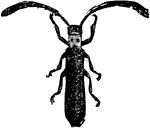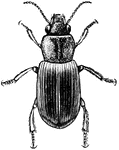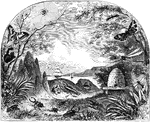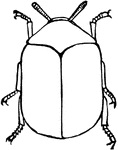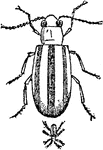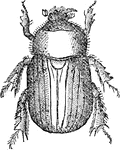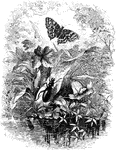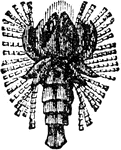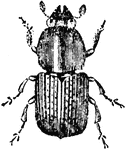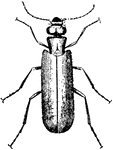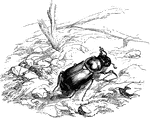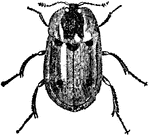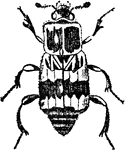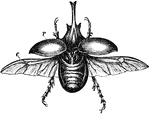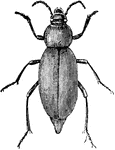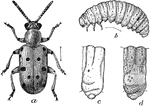
Crioceris 12-Punctata
"The mature beetle in life rivals asparagi in beauty, but may be distinguished by its much broader elytra…
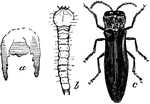
Agrilus
"Agrilus ruficollis. a, anal end of body of larva; b, larva; c, beetle. (The vertical lines show natural…
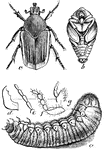
Allorhina
"Allorhina nitida- readily distinguished by the fact that the epimera of the mesothorax are visible…
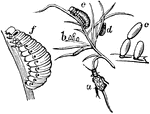
Asparagus Beetle
"Asparagus-Beetle (Crioceris asparagi). a,b,d and e, beetle eggs, and larvæ, natural size; c and…
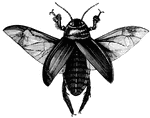
Beetle
Beetles have two pair of wings with the first pair being hard and horny, (Wood, 1896). (Wood, 1896).
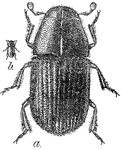
Beetle
This is an illustration of the pine-destroying beetle of the Black Hills; a, adult beetle, enlarged;…
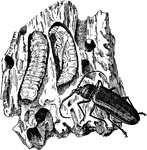
Beetle
Beetles are the group of insects with the largest number of known species. The general anatomy of beetles…

Beetle Borer
Pictured is a beetle borer and its work. The larva bores in the young wood of raspberry and blackberry.
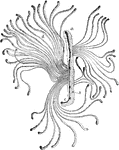
Beetle Damage
This illustration shows a tree that has been damaged by a sprice-destroying beetle. a, primary gallery;…

Asparagus Beetle
Also known as Crioceris asparagi.Spray of asparagus, with common asparagus beetle in its different stages.…

Blackspotted Pliers Support Beetle
"The Leptura Mordax, or Rhagium Mordax of Europe, three-fourths of an inch long,…

Blister Beetle
Beetles (Coleoptera) in the family Meloidae are commonly known as blister beetles, after their defensive…
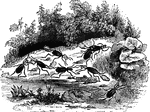
Bombadier Beetle
"The bombadier beetle has a large oval abdomen, which secretes a caustic fluid. They live in societies,…
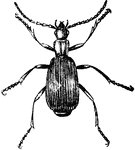
Bombardier Beetle
"These congregate together under stones, and when disturbed discharge a caustic fluid of an extremely…
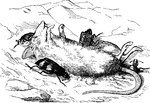
Burying Beetles
"The Burying Beetles are prompted by their insect to bury any small animals or pieces of carrion as…
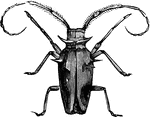
Capricorn Beetle
"The insects of this tribe, called Capricorn Beetles and distributed throughout most parts…

Caterpillar Hunter Beetles
Beetles form a large group of insects that number over 300,000 species. They all have hard wings which…

Churchyard Beetle
"These insects are generally found in dark and dirty places about houses, in cellars, and similar situations."…

Click Beetle
"The Elater striatus of Caenne, is an inch long, of a black color, and striped upon the back."…
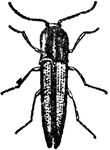
Click Beetle
"Springing Beetles, Elateridae, are narrower and more elongate than the former, and their legs are so…

Click Beetle
Also known as skipjacks. They are a beetle characterized by a click mechanism they possess, which they…
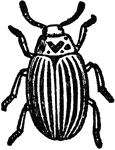
Colorado Beetle
"The Colorado Beetle is a beetle first described by Thomas Say, in 1824, from specimens found by him…

Colorado Beetle Eggs
"The Colorado Beetle is a beetle first described by Thomas Say, in 1824, from specimens found by him…
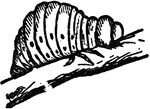
Colorado Beetle Larva
"The Colorado Beetle is a beetle first described by Thomas Say, in 1824, from specimens found by him…
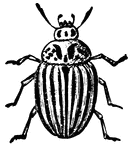
Colorado Potato Beetle
The Colorado potato beetle (Leptinotarsa decemlineata), also known as the Colorado beetle, ten-striped…
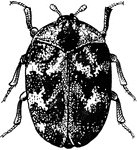
Adult Common Carpet Beetle
An adult common carpet beetle, a small grayish or black beetle belonging to the order Coleoptera.

Common Carpet Beetle Larva
Larva of the common carpet beetle, a small grayish or black beetle belonging to the order Coleoptera.

Common Carpet Beetle Larva
Larva of the common carpet beetle, a small grayish or black beetle belonging to the order Coleoptera.

Common Carpet Beetle Pupa
Pupa of the common carpet beetle, a small grayish or black beetle belonging to the order Coleoptera.

Corn Beetle
"Corn Beetle: a, larva, natural size; b, larva, magnified; c, perfect insect, natural dize; d, perfect…
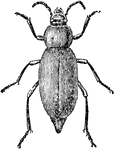
Darkling Beetle
Darkling beetles (also known as Darkening beetles) are a family of beetles found worldwide, estimated…

Diamond Beetle
"Even among the small species several of great beauty are to be met with, and few insects can boast…
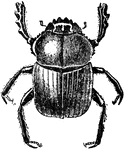
Dung Beetle
"A black insect, with brilliant metallic blue or purple reflections on the under side, and well known…
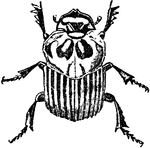
Dung Beetle
"A black insect, with brilliant metallic blue or purple reflections on the under side, and well known…
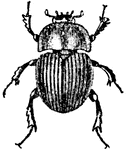
Dung Beetle
"A black insect, with brilliant metallic blue or purple reflections on the under side, and well known…
